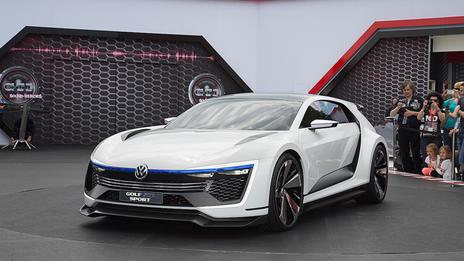Would-be French villains, you’ve been warned. The all-electric Iris Viséo security vehicle just started patrolling select parking lots in France, and it comes with a very unique set of skills. To gain a better view of activity in a parking lot, the car’s cabin can lift nearly 10 feet (3m) into the air while still moving, allowing the driver to assess the surrounding area. The EV is motivated by a 95kW motor producing the equivalent of 127hp. That only propels the Viseo to a top speed of just 15mph, but when you’re driving 10 feet above a parking lot, excessive speed would be the bad guy. The Iris Viséo has a range of 52 miles, takes eight hours to charge and can be purchased by security details everywhere for roughly $50,000.
Hard-charging Volkswagen
At the annual Lake Wörthersee meeting of Volkswagen enthusiasts in Austria, VW took the wraps off of a 396-horsepower, plug-in hybrid Golf GTE Sport Concept. Powered by no fewer than three motors, the GTE Sport combines Volkswagen’s turbocharged direct-injection 1.6-litre Polo R WRC engine – a powertrain with two World Rally Championships to its credit – with an electric motor at each axle. The group thrusts the all-wheel-drive Golf to 62mph (100km/h) from a standstill in an estimated 4.3 seconds. That acceleration is abetted by the body’s lightweight, mostly carbon fibre construction. The concept can also cruise up to 31 miles (50km) under electric power alone, and would return the equivalent of 118mpg. For all its silent speed, the concept doesn’t exactly fly under the radar, given its aggressive bodywork and gullwing-style doors.
Three-wheeled wonder on Swiss streets
In what it hopes will be a viable form of urban transport, the Zurich University of Applied Sciences School of Engineering has unveiled its all-electric three-wheeled BiCar. The pod-like conveyances have a range of about 12 miles, a maximum speed of 18mph and are targeted towards hypothetical city-dwellers who would rent the vehicles for short-distance spurts. The research team thinks people could use partially enclosed BiCars to travel to train stations, rather than fighting for parking spaces in cars or being exposed to the elements on bicycles. A test fleet of 20 vehicles is scheduled to hit Zurich streets in 2017.
Toyota breathes new life into old hybrid batteries
The world’s largest carmaker has partnered with Yellowstone National Park, located in the western US state of Wyoming, for an energy-storage system that feeds solar rays into 208 nickel-metal hydride battery packs previously used in Camry Hybrid models. The packs have been retrofitted to work with a solar power system to provide 85kWh of energy storage – the same amount, coincidentally, provided by Tesla Motors’ top-line pack – for continuous power to the five buildings on the park’s Lamar Buffalo Ranch. Toyota says that systems like this could double the lifespan of hybrid car batteries – a significant development, considering Toyota sells more hybrids than any other carmaker.
London’s black cabs go green
Recently the London Taxi Company revealed that its next line of London Black Cabs will come in the form of a plug-in hybrid, called the TX5. The new cars will be equipped with an electric motor and a gasoline range extender, and will be manufactured in Britain in a new, $381m factory built by Chinese conglomerate Geely, the parent of London Taxi. The current version of the iconic cab, the TX4, will be replaced by the new PHEV before 2017. The move comes as London works to transition its taxi fleet to be zero-emissions-capable by 2018. Any drivers who have already purchased a TX4 will get about $1,500 towards a new TX5. Despite the obvious fuel savings, don’t hold your breath for lower cab fares.
First-ever sodium-ion vehicle
British battery research and development company Faradion unveiled what it calls the first sodium-ion vehicle ever produced – simply called the "e-bike”. The rolling proof of concept is intended to demonstrate sodium-ion batteries’ greater viability over lithium-ion-based units, given sodium-based salts are more cleanly and easily sourced. Faradion claims that the units are 30% less expensive per kilowatt-hour than their lithium-ion equivalents. The batteries also have similar lifespans, and are easier to transport because they don’t have to be partially charged. The potential upside of the tech goes far beyond e-bikes though, and – presuming they test reliably – the units could be used to augment or even replace the supply of lithium-ion batteries in electric and hybrid vehicles.
Google’s autonomous cars hit the road
This summer, those little autonomous prototypes Google debuted in 2014 will move off of the test track and onto the streets of Mountain View, California, where Google’s main campus is located. One of Google’s ambitions is to take driving completely out of the hands of humans, given they cause 94% of accidents.
The cars are only being tested around town and max out at 25mph. As with any self-driving tests, safety drivers will always be in the cars and the prototypes will still count steering wheels and brake pedals in their diminutive cabins. The new vehicles use the same software found in Google’s former autonomous vehicles – modified Lexus RX450h SUVs – which have logged more than 1m self-driving miles to date. Google says the little cars pack the equivalent of 75 years of driving experience into their control software, but let’s hope they are programmed with the reflexes of a 20-year-old.
The self-driving semi-truck is already here
Daimler’s new, self-driving Freightliner Inspiration officially hit the Nevada roads, becoming one of the first, licensed autonomous commercial trucks in the US. The Inspiration’s self-driving feature, called Highway Pilot, is an amalgam of cameras and long and short-range radar technology, paired with speed, braking and collision-avoidance systems, all of which allow the 16-tonne truck to drive itself on highways. Commercially licensed truck drivers have to remain in the cab though, considering the Inspiration’s self-driving features will not work during short trips around town. Daimler says the autonomous Inspiration would reduce accidents, cut down on traffic and improve long-haul fuel efficiency – and give truck drivers a much-needed break.
(BBC)
www.ann.az
Follow us !











